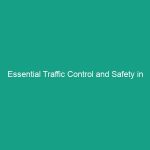Good Morning Team!
Today, we’re going to talk about a vital topic that affects not only our Workplace Safety but also our daily lives: Must-Know Safe Driving Guidelines: Avoid These Critical Risks Today! Safe driving is essential for ensuring the well-being of all employees and maintaining a productive work Environment.
Whether you’re commuting to work, driving company vehicles, or simply running errands, understanding and applying Safe Driving Practices is crucial. Let’s dive into why this topic is so important and how we can all contribute to a safer workplace.
Understanding Safe Driving Guidelines
Safe driving guidelines encompass a set of practices and rules designed to prevent accidents and ensure the Safety of drivers, passengers, and pedestrians. These guidelines are particularly important in the context of Workplace Safety, where the risks can lead to serious injuries or fatalities.
It’s easy to overlook safe driving practices when we’re in a hurry or distracted. However, adhering to these guidelines is essential not only for your Safety but also for the safety of others on the road.
Some common misconceptions about safe driving include:
- “I’m a good driver; I don’t need to follow all the rules.”
- “Accidents only happen to careless drivers.”
- “I can multitask while driving without any issues.”
Key Hazards, Risks, and Safety Considerations
There are numerous Hazards and risks associated with driving that can lead to accidents. Understanding these risks is the first step in mitigating them:
- Distracted Driving: This includes texting, eating, or talking on the phone while driving. These distractions can significantly increase the likelihood of an accident.
- Speeding: Driving above the speed limit reduces your ability to react to sudden changes, increasing the risk of a crash.
- Driving Under the Influence: Alcohol and drugs impair judgment and reaction times, making it extremely dangerous to drive.
- Weather Conditions: Rain, snow, fog, and ice can create hazardous driving conditions that require extra caution.
Ignoring these risks can have real-world consequences, including vehicle damage, injuries, or even fatalities. Each of us has a role to play in preventing these incidents by being vigilant and responsible on the road.
Best Practices, Procedures, & Actionable Advice
To promote a culture of safe driving, it’s essential to follow Best Practices. Here are some actionable steps everyone can take:
1. Stay Focused
Keep your attention on driving at all times. Avoid distractions by:
- Putting your phone on silent or using hands-free devices.
- Eating before you leave or during breaks, not while driving.
- Using GPS or navigation systems before you start driving.
2. Obey Speed Limits
Always adhere to posted speed limits and adjust your speed according to road conditions. Remember:
- Drive slower in adverse weather conditions.
- Be mindful of speed limits in construction zones and residential areas.
3. Never Drive Under the Influence
Driving under the influence of alcohol or drugs is illegal and extremely dangerous. Always plan ahead:
- Use public transportation, taxis, or rideshare services if you plan to drink.
- Designate a sober driver when going out with friends.
4. Adjust for Weather Conditions
Weather can change quickly, and it’s important to adjust your driving accordingly. Here’s how:
- Increase following distance in rain or snow.
- Use headlights in low visibility conditions.
- Know how to handle your vehicle in adverse conditions (e.g., skidding).
5. Conduct Vehicle Maintenance
Ensuring your vehicle is in good condition is crucial for safe driving. Regularly check:
- Tires for proper inflation and tread depth.
- Brakes for responsiveness.
- Lights for functionality.
For instance, a well-maintained vehicle reduces the chances of a breakdown, which can lead to accidents.
Regulations, Standards, and Compliance
Adhering to local and federal Regulations regarding safe driving is critical. Familiarize yourself with:
- OSHA guidelines related to vehicle safety.
- State and local traffic laws.
- Company-specific safety protocols.
Compliance with these regulations not only protects you but also ensures the safety of your coworkers. Failing to comply can result in penalties, accidents, and increased insurance costs.
Employee Engagement & Discussion
Now that we’ve covered the essential guidelines for safe driving, let’s engage in a discussion. I encourage you to think about your experiences:
- What safety challenges have you encountered related to driving?
- How do you ensure safety when driving for work?
- Can you share an incident where safe driving made a difference?
Your insights can help us improve our safety culture and share valuable lessons with one another.
Conclusion & Key Takeaways
In conclusion, safe driving is a shared responsibility that requires our full attention and commitment. Here are the key takeaways:
- Stay focused and avoid distractions.
- Obey speed limits and adjust for weather conditions.
- Never drive under the influence.
- Practice regular vehicle maintenance.
- Adhere to safety regulations and company policies.
By applying these guidelines, we can create a safer environment for ourselves and our colleagues. Thank you for your attention and your commitment to safety. Let’s make every drive a safe drive!


